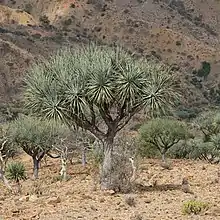| Dracaena ombet | |
|---|---|
 | |
| Scientific classification | |
| Kingdom: | Plantae |
| Clade: | Tracheophytes |
| Clade: | Angiosperms |
| Clade: | Monocots |
| Order: | Asparagales |
| Family: | Asparagaceae |
| Subfamily: | Nolinoideae |
| Genus: | Dracaena |
| Species: | D. ombet |
| Binomial name | |
| Dracaena ombet | |
| Subspecies[2] | |
| |
| Synonyms[2] | |
| |
Dracaena ombet, commonly known as Gabal Elba dragon tree, is a species of plant belonging to the Asparagaceae family, formerly included in the Ruscaceae. It is found in northeastern Africa and the western Arabian Peninsula.
Description
It is a tree that reaches a size of 2-8 m in height, with a forked trunk that produces a red resin. The leaves form dense rosettes at the ends of the branches, these are linear with a broad base, 40-60 x up to 3 cm, gradually tapering to the tip that is sharp, thick and rigid, with smooth margins, flat to concave in the top. The inflorescence is panicle-shaped, 0.5 m long, highly branched, glabrous or pubescent, with tiny, ovate-lanceolate bracts. Whitish tepals, 4-6 mm long, are linear. Stamens are somewhat shorter than tepals; flattened filaments. The fruit in the form of berries 10-12 mm in diameter.[2]
Distribution
It is found at an altitude of 1000-1800 m in Djibouti, Eritrea, Ethiopia, Somalia, Sudan and Saudi Arabia.[2]
Taxonomy
Dracaena ombet was described by Heuglin ex Kotschy & Peyr. and published in Plantae tinneanae sive descriptio plantarum in ... 47, in 1867.[3]
References
- ↑ World Conservation Monitoring Centre (1998). "Dracaena ombet". IUCN Red List of Threatened Species. IUCN. 1998: e.T30395A9535978. doi:10.2305/IUCN.UK.1998.RLTS.T30395A9535978.en.
- 1 2 3 4 "Dracaena ombet". Plants of the World Online. Royal Botanic Gardens, Kew. Retrieved 20 January 2022.
- ↑ "Dracaena ombet". Tropicos. Missouri Botanical Garden. Retrieved 20 January 2022.
Bibliography
- BOULOS, L. (1995). Flora of Egypt. Checklist. Al-Hadara Publishing, Cairo. 283 p. [p.]
- BOULOS, L. (2005). FLORA OF EGYPT. [vol. 4] Al Harara Publishing. Cairo. [p.83]
